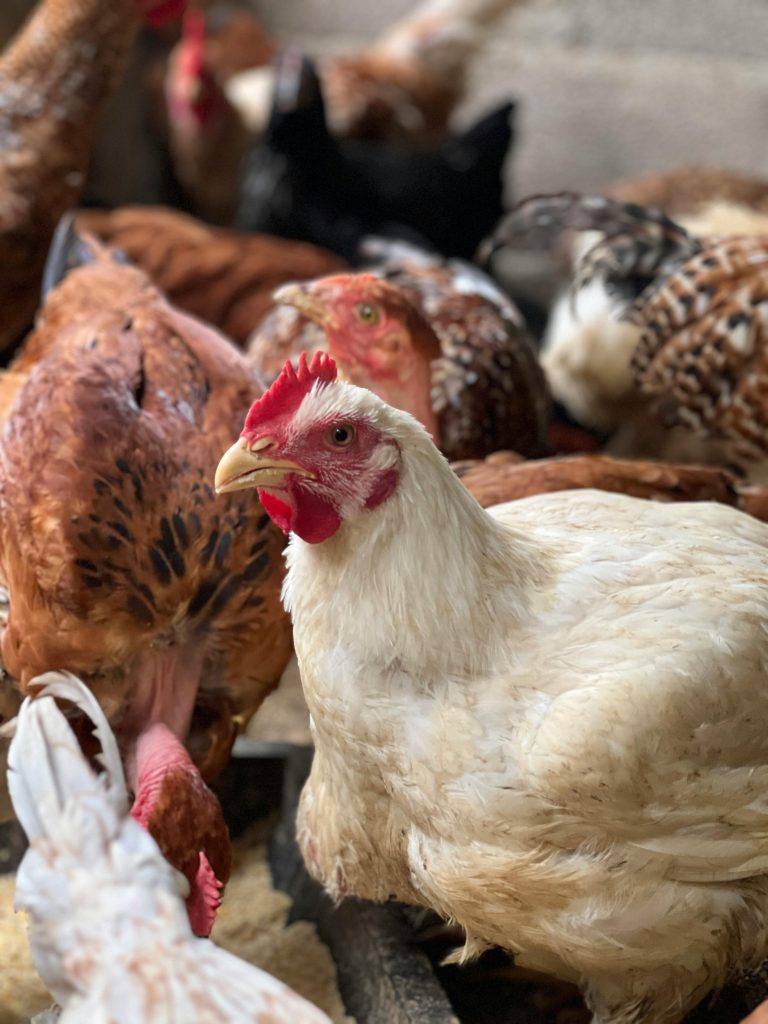Our Products

Chicken
Cobb Chicken (Broiler)
Weight: 1.8–2.5 kg (live weight)
Taste:
Mild, soft meat
Juicy and tender
Best For: Fried chicken, grilled, roasting
Taste:
Mild, soft meat
Juicy and tender
Best For: Fried chicken, grilled, roasting
Kampung Chicken (Ayam Kampung)
Weight: 1.2–1.8 kg (live weight)
Taste:
Rich, aromatic, firmer texture
More flavorful and “chickeny”
Best For: Soup, curry, rendang, traditional dishes
Taste:
Rich, aromatic, firmer texture
More flavorful and “chickeny”
Best For: Soup, curry, rendang, traditional dishes
Cornish Chicken
Weight: 2.5–3.5 kg (live weight)
Taste:
Tender, more meaty than Cobb
Mild, slightly firmer
Best For: Roasting whole, grilled or stuffed
Taste:
Tender, more meaty than Cobb
Mild, slightly firmer
Best For: Roasting whole, grilled or stuffed
Cattle
Brahman
Size: Large; Bulls 800–1,100 kg, Cows 500–700 kg
Taste: Lean with a stronger, more traditional beef flavor
Texture: Slightly firmer—best for slow cooking (stews, curries)
Health: Lower in fat, good for lean protein lovers
Taste: Lean with a stronger, more traditional beef flavor
Texture: Slightly firmer—best for slow cooking (stews, curries)
Health: Lower in fat, good for lean protein lovers
Kampung Cow
Average Live Weight:
Adult Cow: 180–280 kg.
Feeding: Natural grazing—grass, leaves, and local feed
Taste:
Authentic, slightly gamey beef flavor
Leaner meat, rich in aroma
Texture: Firmer than commercial breeds (ideal for slow cooking)
Best for: Gulai kawah, rendang, sup tulang, and traditional recipes
Health: Lower fat and high in protein –great for clean eating
Adult Cow: 180–280 kg.
Feeding: Natural grazing—grass, leaves, and local feed
Taste:
Authentic, slightly gamey beef flavor
Leaner meat, rich in aroma
Texture: Firmer than commercial breeds (ideal for slow cooking)
Best for: Gulai kawah, rendang, sup tulang, and traditional recipes
Health: Lower fat and high in protein –great for clean eating
Charolais
Cows 700–900 kg
Taste: Mild, clean beef flavor
Texture: Lean but tender, slightly firmer than Angus
Health: Lower fat, high protein—ideal for clean eating
Best For: Roasts, kebabs, and healthy cooking
Taste: Mild, clean beef flavor
Texture: Lean but tender, slightly firmer than Angus
Health: Lower fat, high protein—ideal for clean eating
Best For: Roasts, kebabs, and healthy cooking


Mutton
Kacang
Origin: Malaysia/Indonesia
Use: Meat (dual-purpose in some areas)
Weight: Male 25–35 kg
Growth Rate: Moderate
Meat Quality: Lean and tasty.
Use: Meat (dual-purpose in some areas)
Weight: Male 25–35 kg
Growth Rate: Moderate
Meat Quality: Lean and tasty.
Black Bengal
Origin: Bangladesh/India
Use: Meat & Skin
Weight: Male 25–30 kg.
Growth Rate: Slow to moderate
Meat Quality: Premium – very tasty, low fat
Use: Meat & Skin
Weight: Male 25–30 kg.
Growth Rate: Slow to moderate
Meat Quality: Premium – very tasty, low fat
Dopper (Dorper)
Origin: South Africa
Use: Meat (sheep, not goat)
Weight: Male 25-35 kg.
Growth Rate: Very fast
Meat Quality: High—tender, mild flavor.
Use: Meat (sheep, not goat)
Weight: Male 25-35 kg.
Growth Rate: Very fast
Meat Quality: High—tender, mild flavor.
Fish
Tilapia
Types: Red Tilapia, Black Tilapia
Size: 600g–1.5kg
Growth Rate: Fast (4–6 months)
Taste: Mild and clean flavor, versatile for cooking
Market Demand: Very high—popular across all markets
Size: 600g–1.5kg
Growth Rate: Fast (4–6 months)
Taste: Mild and clean flavor, versatile for cooking
Market Demand: Very high—popular across all markets
Keli (Catfish)
Types: Clarias gariepinus (African), Clarias batrachus (local)
Size: 800g–1.5 kg
Growth Rate: Fast (2.5–4 months to harvest)
Taste: Soft texture, mild flavor
Market Demand: High—affordable, widely consumed in urban and rural areas
Size: 800g–1.5 kg
Growth Rate: Fast (2.5–4 months to harvest)
Taste: Soft texture, mild flavor
Market Demand: High—affordable, widely consumed in urban and rural areas
Puyu (Climbing Perch)
Size: 200–500g
Growth Rate: Moderate (4–6 months to market size
Taste: Firm, slightly sweet, traditional favorite
Market Demand: Niche—high among traditional and rural consumers


Eggs
Egg A
Category A Kampung Eggs
Weight Range: 60g and above per egg
Shell Appearance: Slightly larger and more uniform in shape
Yolk Color: Usually deep orange to bright yellow (varies by diet)
Taste & Quality: Rich, flavorful, often used for high-end cooking and baking
Price: Highest among all categories due to larger size and better quality
Usage:
Premium culinary dishes
Health-conscious consumers
Gourmet restaurants and cafes
Weight Range: 60g and above per egg
Shell Appearance: Slightly larger and more uniform in shape
Yolk Color: Usually deep orange to bright yellow (varies by diet)
Taste & Quality: Rich, flavorful, often used for high-end cooking and baking
Price: Highest among all categories due to larger size and better quality
Usage:
Premium culinary dishes
Health-conscious consumers
Gourmet restaurants and cafes
Eggs B
Category B Kampung Eggs
Weight Range: 52g – 59g per egg
Shell Appearance: Medium size, slightly less uniform than Grade A
Yolk Color: Deep yellow to orange
Taste & Quality: Still rich in taste and nutrients
Price: Moderate price range
Usage:
Daily household consumption
Food stalls, mid-tier restaurants
Small-scale baking
Weight Range: 52g – 59g per egg
Shell Appearance: Medium size, slightly less uniform than Grade A
Yolk Color: Deep yellow to orange
Taste & Quality: Still rich in taste and nutrients
Price: Moderate price range
Usage:
Daily household consumption
Food stalls, mid-tier restaurants
Small-scale baking
Eggs C
Category C Kampung Eggs
Weight Range: 45g – 51g per egg
Shell Appearance: Smaller size, may be irregular in shape
Yolk Color: Yellow to light orange
Taste & Quality: Slightly lighter flavor, still healthier than regular eggs
Price: Most affordable kampung egg option
Usage:
Budget-conscious consumers
Bulk purchase for food preparation
Often used in egg-based batters or sauces
Weight Range: 45g – 51g per egg
Shell Appearance: Smaller size, may be irregular in shape
Yolk Color: Yellow to light orange
Taste & Quality: Slightly lighter flavor, still healthier than regular eggs
Price: Most affordable kampung egg option
Usage:
Budget-conscious consumers
Bulk purchase for food preparation
Often used in egg-based batters or sauces
